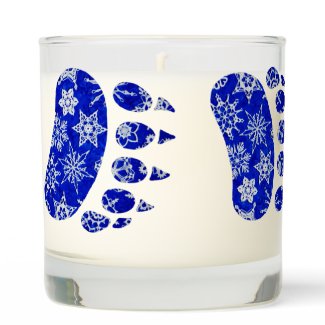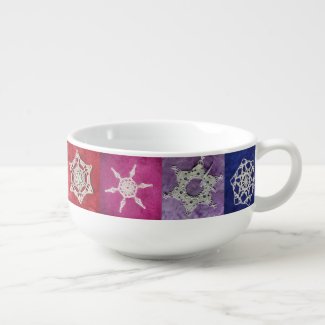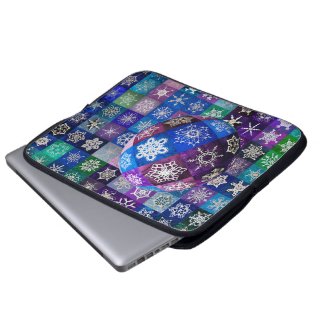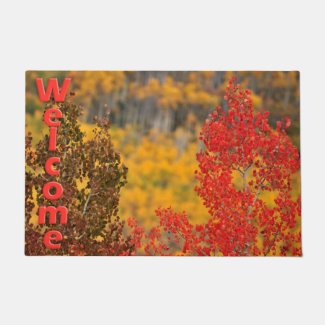
Back when I first found Picotee Amaryllis, I thought they were hot, Hot, HOT! I ordered one of my own right away, and it bloomed this year. The most stunning amaryllis I've ever seen! I just had to crochet one!
I was eating lunch while working up my prototype crocheted amaryllis, and I accidentally spilled some sriracha dressing on it. So now it's REALLY hot...
Needless to say, a redesign was in order, and not just because I wasn't happy with the first stab at the top layer of petals.

Last winter was the first time I'd ever tried growing amaryllis, so I didn't know very much about the care of the flower. When my gorgeous blooms appeared, I decided to take a cotton swab to the pollen and pretend to be a busy bee. Shortly thereafter, my white Picotee Amaryllis appeared to be pregnant with quadruplets!

By this time, I'd done some research and learned you can actually pollinate the amaryllis and allow it to form seeds, although the energy it expends on making seeds may keep it from flowering as productively the following winter. Also, I learned most amaryllis varieties are hybrids, so the seeds may not produce the same kind of amaryllis as the parent. Also, not all the seeds may be viable.
About six weeks after the pregnancy occurred, the seed pods began to dry out and crack open, revealing... SEEDS! Hundreds of seeds!

I collected the seeds and bought starter kits but then realized I don't have enough room in my house for any more seedlings until everything I've been protecting from the weather goes outside, which may not be until the end of May or beginning of June, and then, I have to introduce them slowly so they won't be shocked.
Once the current indoor stuff goes outside for summer, then I can start the amaryllis process in the vacated space. The seeds that sprout will take about three to five years to flower, so it's sort of like adopting hundreds of babies for a few years.

Meanwhile, I learned how to help my parent white Picotee Amaryllis (and the red one I bought on clearance well after Christmas) have a better chance of flowering this Christmas. I will keep feeding them until about the middle of September, then stick them in the basement for two months to stay cool and dark, and I won't have to water them. Then back upstairs they come to sit in a sunny window and hopefully bloom right in time for Christmas.

Perhaps in about four years I'll have an entire amaryllis forest!!! For now, a crocheted amaryllis forest will have to do!
You may do whatever you'd like with flowers and/or snowflakes you make from this pattern, but you may not sell or republish the pattern. Thanks, and enjoy!

Finished Size: snowflake, 5 inches from point to point; flower, 2 inches from point to point
Materials: Size 10 crochet thread in 5 colors (I used white or cream, bright green, yellow and red or maroon for flower and variegated green and white for snowflake), size 7 crochet hook, empty pizza box, wax paper or plastic wrap, cellophane tape, water soluble school glue or desired stiffener, water, glitter, small container for glue/water mixture, paintbrush, stick pins that won't be used later for sewing, clear thread or fishing line
Note: Amaryllis picot edge may alternatively be made with sewing thread or embroidery floss or may be carefully drawn with red permanent marker. BE SURE TO TEST PERMANENCE OF MARKER AND STIFFENING METHOD ON THREAD SCRAPS FIRST.
Amaryllis Snowflake Instructions
With bright green or flower center color, make magic ring.
Round 1: 6 sc in ring. Pull magic circle tight.
Round 2: 1 sc in starting sc of 1st Round, * ch 4, 1 sc in 2nd ch from hook and in each of next 2 ch, 2 sc in next sc of ring, 1 sc in next sc; repeat from * around 2 times, omitting last sc of final repeat; sl st in starting sc; bind off. Weave in ends.
NOTE: If desired, dab ends with a tiny drop of glue and massage into thread to secure ends. Allow to dry thoroughly. Repeat this step with each color change if desired.

Round 3: With yellow or 2nd flower center color, * 1 sc in top (or next in repeats) of any spoke, 5 tr in center ring sc between spokes; repeat from * around 2 times; sl st in starting sc; bind off. Motif will have a cup-like shape, and that's okay.

Round 4: With white or cream or petal color, * 1 sc in first tr of any 5/tr group (or next tr of any 5/tr group in repeats) and in next tr, 5 dc in next dc, 1 sc in each of next 2 tr; repeat from * around 2 times; do not join.
Round 5: * 1 sc in next sc, 1 hdc in next sc, 3 dc in next dc, 1 dc in next dc, 3 dc in next dc, ch 1, sl st in top of dc just made (picot petal point made), 2 dc in same dc, 1 dc in next dc, 3 dc in next dc, 1 hdc in next sc, 1 sc in next sc, sl st in top of bright green spoke; repeat from * around 2 times; bind off. Weave in ends.
Round 6: With red or picotee edging color sl st in each back loop only around, skipping sc and with ch 2 picot at each petal point; bind off.
NOTE: Alternately, embroidery floss or sewing thread may be wrapped around back loop only all the way around, or a red permanent marker may be used to mark the back loop only all the way around. Flower edge also may be left white or petal color, with no edging, if desired.
If you're not reading this pattern on Snowcatcher, you're not reading the designer's blog. Please go here to see the original.
Round 7: With white or cream or petal color and working from the back of motif, 1 dc through at least 2 yellow (or second flower center color) dc loops of any 3/dc group; [ch 5, 1 dc through at least 2 yellow dc loops of next 3/dc group] 2 times; ch 5, sl st in starting dc.
Round 8: * In next ch 5 sp, work [1 sc, 1 hdc, 1 dc, 5 tr, 1 dc, 1 hdc, 1 sc]; repeat from * around 2 times, sl st in starting sc.
Round 9: * Skipping over sc, 1 hdc in each of next 2 st; 3 dc in next st, 1 dc in next st, 3 tr in next st, ch 1, sl st in top of tr just made (petal picot point made), 2 tr in same st, 1 dc in next st, 3 dc in next st, 1 hdc in each of next 2 st, sl st between next 2 sc; repeat from * around 2 times; bind off. Weave in ends.
Round 10: With red or picotee edging color sl st in each back loop only around, skipping sc and with ch 2 picot at each petal point; bind off. Weave in ends.
If making flower only and not snowflake, skip to finishing instructions.

Snowflake Rounds
Round 11: Working on back side of motif, with white (or green if making leaves), * 1 dc in bottom loops of middle dc of any Round 8 5/dc group (or middle dc of next 3/dc group in repeats), ch 5, 1 dc through next sc joint between petals, ch 5; repeat from * around 2 times, omitting last 3 ch of final repeat; 1 tr in starting dc to form 6th ch 5 sp of Round.
Round 12: Ch 2 (counts as 1 dc), 1 dc over post of tr directly below, 2 hdc in same sp, 1 sc in same sp, * 1 sc in next ch 5 sp, 2 hdc in same sp, 2 dc in same sp, ch 3, 2 dc in same sp, 2 hdc in same sp; 1 sc in same sp; repeat from * around 4 times; 1 sc in next ch 5 sp, 2 hdc in same sp, 2 dc in same sp, ch 1, 1 dc in 2nd ch of starting ch 2 to form 6th ch 3 sp of Round. (If making leaves, bind off green here and work remainder of Rounds in white.)
Round 13: Ch 2 (counts as 1 dc), 1 dc over post of dc directly below, * ch 3, 1 dc in gap between next 2 sc, ch 3, 2 dc in next ch 3 tip, ch 3, 2 dc in same tip; repeat from * around 4 times; ch 3, 1 dc in gap between next 2 sc, ch 3, 2 dc in next ch 3 tip, ch 1, 1 dc in 2nd ch of starting ch 2 to form 6th ch 3 tip of Round.
Round 14: Ch 2 (counts as 1 dc), 2 dc over post of dc directly below, * ch 3, 1 sc in next ch 3 sp, ch 5, 1 sc in next ch 3 sp, ch 3, 3 dc in next ch 3 tip, ch 3, 3 dc in same tip; repeat from * around 4 times; ch 3, 1 sc in next ch 3 sp, ch 5, 1 sc in next ch 3 sp, ch 3, 3 dc in next ch 3 tip, ch 1, 1 dc in 2nd ch of starting ch 2 to form 6th ch 3 tip of Round.
Round 15: Ch 2 (counts as 1 dc), 3 dc over post of dc directly below, * ch 3, [1 sc in next ch 3 sp, ch 5] 2 times, 1 sc in next ch 3 sp, ch 3, 4 dc in next ch 3 tip, ch 3, 4 dc in same tip; repeat from * around 4 times; ch 3, [1 sc in next ch 3 sp, ch 5] 2 times, 1 sc in next ch 3 sp, ch 3, 4 dc in next ch 3 tip, ch 1, 1 dc in 2nd ch of starting ch 2 to form 6th ch 3 tip of Round.
Round 16: Ch 2 (counts as 1 dc), 4 dc over post of dc directly below, * ch 3, [1 sc in next ch 3 sp, ch 5] 3 times, 1 sc in next ch 3 sp, ch 3, 5 dc in next ch 3 tip, ch 3, sl st in 3rd ch from hook (picot made), 5 dc in same tip; repeat from * around 4 times; ch 3, [1 sc in next ch 3 sp, ch 5] 3 times, 1 sc in next ch 3 sp, ch 3, 5 dc in next ch 3 tip, ch 3, sl st in 3rd ch from hook (picot made), sl st in 2nd ch of starting ch 2; bind off. Weave in ends.
Finish: If making the flower only, amaryllis does not necessarily require stiffening, but dabbing a drop of glue over the ends to secure them will help prevent unraveling.
Tape wax paper or plastic wrap to top of empty pizza box. Pin snowflake to box on top of wax paper or plastic wrap.
If using glue, mix a few drops of water with a teaspoon of glue in small washable container. Paint snowflake with glue mixture or desired stiffener. Sprinkle lightly with glitter. Wash paintbrush and container thoroughly. Allow snowflake to dry at least 24 hours. Remove pins. Gently peel snowflake from wax paper or plastic wrap. Attach 10-inch clear thread to one spoke, weaving in end. Wrap fishing line around tree branch (or tape to ceiling or any overhead surface) and watch the snowflake twirl freely whenever you walk by! Snowflake also may be taped to window or tied to doorknob or cabinet handle.






































That would be quite the forest. You may have to get more property lol maybe the spill was just trying to help with the "hot" too.
ReplyDeleteThe "hot" may have needed a little more color than I gave it, Pat! :)
Delete